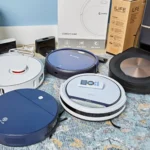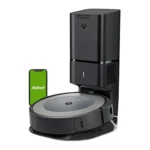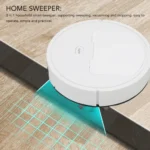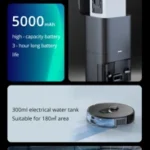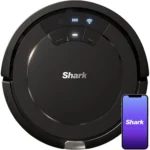Introduction: The Problem of Manual Labor in House Chores
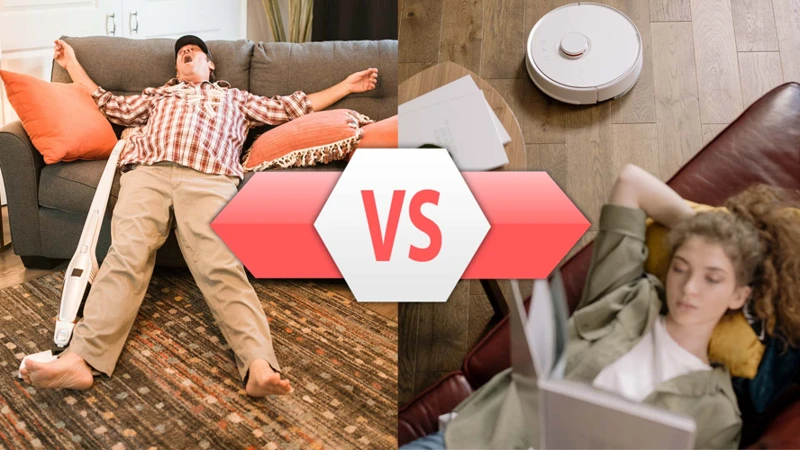
Are you tired of spending countless hours cleaning your home? Do you wish there was an easier way to tackle the never-ending task of house chores? If so, you’re not alone. The problem of manual labor in house cleaning is a common one, and many people are seeking solutions to simplify the process.
Fortunately, technological advancements have brought us smart vacuum cleaners, which is a game-changer in the world of house cleaning. These high-tech devices are designed to make cleaning easier and more efficient than ever before. But, are they really worth the investment when compared with traditional vacuum cleaners?
In this article, we’ll take an in-depth look at the two types of vacuum cleaners- smart vacuum cleaner and traditional vacuum cleaner – to determine which one is the better option for your cleaning needs.
But before we dive deep, let’s first understand the problem at hand. The manual labor involved in house cleaning is not just a hassle, but can also cause physical strain, especially for the elderly or disabled. Pet owners have to deal with the added task of cleaning pet hair and dander, which can be a never-ending battle without proper equipment.
Smart vacuum cleaners are the perfect solution for these problems. With its advanced sensors and mapping technology, pet owners can remove more pet hair and dander from their homes, while the elderly or disabled can easily clean their homes without physical strain. For those with busy schedules, smart vacuums can be scheduled to clean specific rooms at specific times with minimal effort, thereby making it easier to keep a clean home.
Another important concern with traditional vacuum cleaners is that they are not always eco-friendly; they can have a significant impact on indoor air quality, particularly if they are not equipped with proper filters. On the other hand, a smart vacuum cleaner can indeed improve indoor air quality through its advanced filtration system.
While there are a variety of benefits to smart vacuum cleaners, traditional vacuum cleaners still have their place. It’s important to weigh the pros and cons of both types of vacuums to determine which one is right for you. In the following sections, we’ll explore both types of vacuum cleaners to help you make an informed decision.
What Is a Smart Vacuum Cleaner?
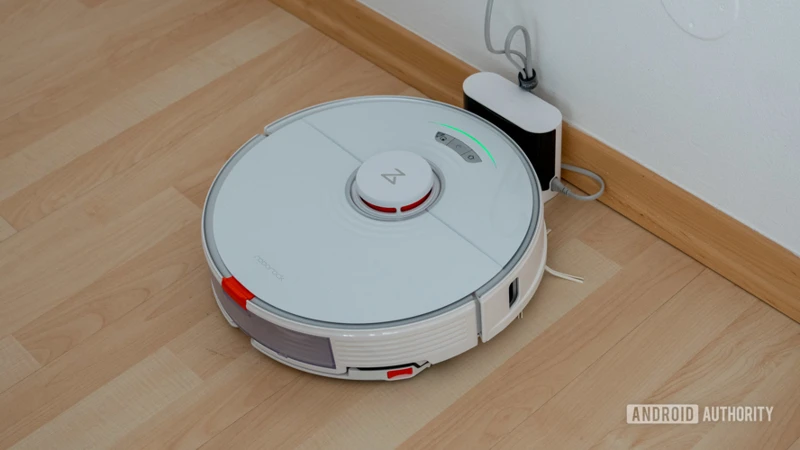
The world is rapidly changing, and technology innovations have become a way of life. From smartphones to wearables, technology has advanced and simplified various aspects of our lives. It’s no different when it comes to household chores. House cleaning can be a daunting task, especially for the elderly or disabled. However, with the advent of smart vacuum cleaners, it has become easier and convenient to keep your house clean. Smart vacuum cleaners come with a range of features that make house cleaning more efficient and hassle-free. Let’s dig deeper into what a smart vacuum cleaner is, how it works and its pros and cons. For more information on how smart vacuum cleaners can help the elderly or disabled, check out this article.
How Does a Smart Vacuum Cleaner Work?
Smart vacuum cleaners are an innovative technology that has made house cleaning much easier and more convenient. With the invention of sensors and mapping technology, smart vacuum cleaners have become a lot more effective in cleaning floors. These robots are designed to map the environment they’re cleaning, which allows them to navigate your house autonomously. How does this work? Here are the main steps involved in the process:
- Mapping: When you start your robot vacuum, it begins the process of mapping your house layout. It makes a mental map of every room in the house using sensors, which include microphones, lasers, infrared sensors, and cameras. Some models also come with a physical boundary marker that helps the robot not to cross over.
- Cleaning: Once the mapping process is complete, the smart vacuum starts cleaning. The robot uses its sensors and cameras to detect dust, debris, and pet hair, and then it removes them from the floors efficiently. You can schedule your smart vacuum cleaner to clean at specific times, so you don’t have to be home to start the cleaning process.
- Charging: Once the cleaning cycle is complete, the smart vacuum cleaner usually docks itself to the charging station. It might not always return itself so you might need to help it if it gets lost or stuck. This self-charging feature ensures that the robot vacuum is always ready for the next cleaning cycle.
In addition to mapping and cleaning, smart vacuum cleaners have several benefits over traditional vacuum cleaners. They are ideal for pet owners, as they can help prevent allergies by removing pet hair and dander. They can improve your indoor air quality. They also provide an environmentally-friendly option as they consume less electricity and clean more efficiently as compared to traditional cleaners.
What Are the Pros and Cons of a Smart Vacuum Cleaner?
Smart vacuum cleaners have become increasingly popular in recent years due to their advanced technology and convenience. Let’s take a look at the pros and cons of using a smart vacuum cleaner in your home.
| Pros | Cons |
|---|---|
| Efficiency: Smart vacuums use advanced sensors and mapping technology to navigate your home and clean efficiently without missing spots. | Price: Smart vacuum cleaners can be more expensive than traditional vacuums due to their advanced technology and features. |
| Convenience: Smart vacuums can be controlled remotely using apps or voice assistants, allowing you to clean on a schedule or even while you’re away from home. | Maintenance: Smart vacuums may require more maintenance than traditional vacuums due to their advanced technology. |
| Advanced Features: Smart vacuums may come with features such as mapping, scheduling, and auto-docking that traditional vacuums do not have. | Environmental Impact: Smart vacuums may consume more energy than traditional vacuums due to their advanced technology and features. |
While smart vacuum cleaners offer advanced features and convenience, they may come at a higher price point and require more maintenance. Additionally, they may consume more energy and have a potentially greater environmental impact than traditional vacuum cleaners. However, smart vacuum cleaners may also provide more efficient cleaning and improved indoor air quality due to their advanced sensors and mapping technology.
If you’re interested in learning more about the sensors and mapping technology used in smart vacuums, check out our article on Smart Vacuum Sensors and Mapping Technology. For more information on the environmental impact of smart vacuums, read our article on Smart Vacuum Cleaners and the Environment. Finally, to learn more about how smart vacuum cleaners can improve your indoor air quality, check out our article on How Smart Vacuum Cleaners Can Improve Your Indoor Air Quality.
What Is a Traditional Vacuum Cleaner?

When it comes to keeping our homes clean, a traditional vacuum cleaner may spring to mind as a go-to cleaning tool. These trusty machines have been around for decades, but as technology evolves, so do our cleaning options. However, some may still be perplexed by what a traditional vacuum cleaner entails. Let’s dive into what a traditional vacuum cleaner is and how it works to keep your home clean.
How Does a Traditional Vacuum Cleaner Work?
A traditional vacuum cleaner, which is also known as an upright vacuum, uses a combination of suction and agitation to collect dirt and debris from surfaces, such as carpets and floors. The following table breaks down the main components of a traditional vacuum cleaner and how they work together:
| Component | Function |
|---|---|
| Motor | The motor creates suction, which pulls in dirt and debris through the vacuum’s intake. |
| Fan | The fan helps to move air through the vacuum, which in turn helps to create suction. |
| Filter | The filter traps dust and dirt particles that are sucked up into the vacuum. Some traditional vacuum cleaners may have replaceable filters, while others have reusable ones that can be washed and reused. |
| Brushroll | The brushroll, also known as the beater bar, is a rotating cylinder with bristles that agitate the carpet fibers to loosen dirt and debris. The suction then pulls the dirt and debris into the vacuum. |
| Dustbin or Bag | The dustbin or bag collects the dirt and debris that is sucked up by the vacuum. Traditional vacuum cleaners usually have a bag that needs to be replaced periodically, while some newer models have dustbins that can be emptied and reused. |
| Hose and Attachments | The hose and attachments allow you to clean hard-to-reach areas, such as corners and crevices, as well as upholstery and other surfaces. |
Traditional vacuum cleaners have been the go-to choice for cleaning floors and carpets for many years due to their reliability and effectiveness. However, they do require some manual effort to use, and the bags or dustbins need to be replaced or emptied regularly.
What Are the Pros and Cons of a Traditional Vacuum Cleaner?
The traditional vacuum cleaner has been a staple in households for decades. While it may not have the smart technology of its newer counterpart, there are still some advantages to using a traditional vacuum cleaner. Let’s take a closer look at the pros and cons.
Pros of a Traditional Vacuum Cleaner:
- Effective at Removing Deep Dirt: Traditional vacuum cleaners are equipped with powerful suction capabilities that can remove dirt and debris embedded deep within the carpet fibers, making them an excellent option for those with high traffic areas or pets.
- More Affordable: If you’re on a tight budget, a traditional vacuum cleaner is a more cost-effective option than a smart vacuum cleaner. You can usually find a reliable traditional vacuum cleaner for less than $100.
- No Need for Wi-Fi: Unlike smart vacuum cleaners, you don’t need Wi-Fi or a compatible smartphone to use a traditional vacuum cleaner. Simply plug it in and start cleaning.
- Durable: Traditional vacuum cleaners are built to last, with their sturdy construction and simple design. They can withstand years of use without needing costly repairs or maintenance.
Cons of a Traditional Vacuum Cleaner:
- Less Convenient: Traditional vacuum cleaners are heavier and bulkier than their smart counterparts, making them more difficult to maneuver and store.
- No Smart Features: As mentioned earlier, traditional vacuum cleaners lack the smart technology that smart vacuum cleaners have. They don’t have features like scheduling, remote control, or voice-activated commands.
- Noisy: Traditional vacuum cleaners tend to be louder than smart vacuum cleaners, which can be a problem if you’re trying to clean while others are sleeping or working from home.
- Requires Manual Operation: Unlike smart vacuum cleaners, which can operate automatically, traditional vacuum cleaners require manual operation. This can be tiring and time-consuming, especially if you have a large home.
As you can see, there are both advantages and disadvantages to using a traditional vacuum cleaner. It really comes down to your personal preferences and needs. If you have a tight budget and don’t mind doing the cleaning manually, a traditional vacuum cleaner may be the best choice for you. However, if you value convenience and the latest technology, a smart vacuum cleaner may be more suitable. Ultimately, the decision is yours.
Smart Vacuum Cleaner vs. Traditional Vacuum Cleaner: Which One Is Better for Your Needs?
When it comes to choosing the most efficient vacuum cleaner for your home, the decision can be overwhelming. With so many options available, such as the smart vacuum cleaner and the traditional vacuum cleaner, it can be difficult to determine which one best suits your needs. Factors such as performance, convenience, price, and environmental impact all play a significant role in making your decision. In this comprehensive comparison, we’ll explore the pros and cons of each option, helping you make an informed choice that will significantly reduce your manual labor in housework.
Efficiency and Performance
When it comes to efficiency and performance, both smart vacuum cleaners and traditional vacuum cleaners have their own advantages and disadvantages. Here’s a side-by-side comparison of how they stack up:
| Smart Vacuum Cleaner | Traditional Vacuum Cleaner | |
|---|---|---|
| Cleaning Power | Smart vacuum cleaners are equipped with powerful motors and suction technology that allows them to clean carpets, hardwood floors, and other surfaces with ease. They can detect when an area needs more cleaning and can adjust their suction accordingly. | Traditional vacuum cleaners have been around for decades and have a reputation for being powerful cleaning tools. They come with various attachments and settings to tackle different surfaces, but they may not be as efficient as smart vacuums when it comes to detecting dirt and debris. |
| Cleaning Coverage | Smart vacuums are equipped with sensors that allow them to navigate around furniture, stairs, and other obstacles. They can also map out the layout of your home and remember where they have already cleaned. This means they can clean every corner of your home without leaving any areas untouched. | Traditional vacuums require more manual control and may not be as adept at navigating around obstacles. They can however be used for spot cleaning and reaching tight spaces better due to their hose attachments. |
| Noise Level | Smart vacuums are designed to be quieter than traditional vacuums, thanks to their sophisticated motor technology. This makes them ideal for households with sleeping babies, pets or people who don’t want to be disturbed. | Traditional vacuums tend to be noisier due to their use of power cords and larger, more powerful motors. This can make them unpleasant to use early in the morning or in small apartments where noise carries. |
Smart vacuum cleaners are generally more efficient and effective when it comes to cleaning power and coverage. However, traditional vacuums still have their uses as they can handle spot cleaning more accurately and can reach tight spaces better. Ultimately, the decision between the two depends on your cleaning needs and preferences.
Convenience and Ease of Use
One of the key things that people look for when it comes to vacuums is convenience and ease-of-use. In this aspect, both smart vacuum cleaners and traditional vacuum cleaners have their pros and cons.
Pros of Smart Vacuum Cleaners:
- Smart vacuum cleaners are generally smaller and lighter than traditional vacuum cleaners, which makes them easier to move around the house and reach tight spaces.
- With smart vacuum cleaners, you can set up a cleaning schedule that works for you and let the cleaner do the work while you’re away from home.
- Smart vacuum cleaners can be controlled using a mobile app or voice commands, which means that you don’t have to physically interact with the cleaner itself.
Cons of Smart Vacuum Cleaners:
- Smart vacuum cleaners require regular maintenance, including emptying the dustbin and cleaning the brushes, which can be time-consuming.
- Smart vacuum cleaners can be relatively expensive compared to traditional vacuum cleaners.
- Some smart vacuum cleaners may struggle with certain types of terrain, such as shag carpet, stairs, or high-pile rugs.
Pros of Traditional Vacuum Cleaners:
- Traditional vacuum cleaners can be more powerful than smart vacuum cleaners, making them better for deep cleaning carpets and upholstery.
- There is a wider variety of traditional vacuum cleaners on the market, so you can choose one that suits your specific needs and budget.
- Traditional vacuum cleaners are generally easier to repair, as the parts are widely available and the technology is more straightforward.
Cons of Traditional Vacuum Cleaners:
- Traditional vacuum cleaners can be heavy and cumbersome, making them difficult to maneuver around the house and reach tight spaces.
- Traditional vacuum cleaners require you to physically push them around, which can be tiring, especially for people with back pain or mobility issues.
- Traditional vacuum cleaners can be noisy and disruptive, making them less suitable for use while people are sleeping or working.
The choice between a smart vacuum cleaner and a traditional vacuum cleaner will depend on your individual needs and preferences. If you value convenience and automation, then a smart vacuum cleaner may be a better option for you. On the other hand, if you prioritize deep cleaning power and versatility, then a traditional vacuum cleaner may be the way to go. It’s important to consider factors like price, maintenance, and ease-of-use when making your decision.
Price and Maintenance
When it comes to price, smart vacuum cleaners tend to be pricier than traditional ones. However, it’s important to consider the long-term cost as well. While traditional vacuums may have a lower initial price, they require frequent expenses on replacement bags, filters, and belts. Smart vacuums typically don’t require any replacement parts and have longer warranties, so in the long run, they can be more cost-effective.
In terms of maintenance, traditional vacuums require more hands-on involvement. Bags need to be changed regularly, filters need to be washed or replaced, and belts need to be checked frequently for wear and tear. Smart vacuums, on the other hand, have self-cleaning mechanisms and easy-to-remove debris bins that make maintenance a breeze. Some even have companion apps that automatically alert you to any needed maintenance.
Here are some additional points to consider when comparing the price and maintenance of smart vacuum cleaners and traditional vacuum cleaners:
- Repairs: Traditional vacuums tend to have more parts that can break or malfunction, requiring costly repairs. Smart vacuums are typically designed with fewer mechanical parts, making them less likely to need repairs.
- Energy efficiency: Smart vacuum cleaners are often designed to be more energy-efficient than traditional vacuums, which can also lead to cost savings over time.
- Accessories: Traditional vacuums come with a variety of interchangeable accessories, which can add to the overall cost of the vacuum. Smart vacuums may have fewer accessories available, but they often have advanced features built-in that don’t require additional purchases.
Ultimately, when considering the price and maintenance of smart vacuum cleaners versus traditional vacuum cleaners, it’s important to take a holistic view of the long-term cost and convenience of each option. While smart vacuums may have a higher initial price tag, the lack of ongoing maintenance and repair costs can make them a more economical choice over time.
Environmental Impact
When it comes to choosing between a smart vacuum cleaner and a traditional one, one of the factors that can weigh heavily on your decision is their environmental impact. In today’s world where sustainability has become a buzzword, everyone wants to minimize their carbon footprint as much as possible. In this section, we’ll take a closer look at the environmental impact of both types of vacuum cleaners.
Smart Vacuum Cleaner
Smart vacuum cleaners are generally more eco-friendly than traditional ones. Here’s why:
- They are designed to clean your home more efficiently, with less waste of energy and resources.
- Their advanced sensors and mapping technology enable them to navigate your home more intelligently, avoiding unnecessary cleaning and reducing the amount of time and energy spent on cleaning.
- They are usually equipped with high-efficiency filters that can capture even the smallest dust particles, improving air quality in your home.
- Many smart vacuum cleaners are designed to be rechargeable, reducing the number of batteries that end up in landfills.
Traditional Vacuum Cleaner
Traditional vacuum cleaners, on the other hand, are not known for their eco-friendliness. Here are some of the environmental concerns associated with them:
- They consume a lot of energy, often more than a smart vacuum cleaner, due to their less efficient motors.
- Many traditional vacuum cleaners use disposable bags, which can add up to a significant amount of waste over time.
- Their filters are often less efficient than those of smart vacuum cleaners, which means they don’t capture as much dust and debris, leading to lower air quality.
- Their heavy and bulky design requires more energy and resources to manufacture and transport, increasing their carbon footprint.
Conclusion
It’s clear that when it comes to environmental impact, smart vacuum cleaners are the better choice. They are designed to be more efficient, reduce waste, and improve air quality in your home. That being said, traditional vacuum cleaners can still be a good choice if you opt for a bagless model and make sure to properly dispose of the dust and debris collected. Ultimately, it’s up to you to weigh the pros and cons and decide which option aligns better with your environmental values.
| Smart Vacuum Cleaner | Traditional Vacuum Cleaner | |
|---|---|---|
| Efficiency | High | Low |
| Energy Consumption | Low | High |
| Filters | High-efficiency | Less efficient |
| Design | Lightweight and compact | Heavy and bulky |
| Waste Reduction | Rechargeable, less batteries needed | Many models use disposable bags |
Conclusion: Making Your Choice
After considering the pros and cons of both smart vacuum cleaners and traditional vacuum cleaners, you may be wondering which one to choose. The decision ultimately comes down to your specific needs and priorities.
If you value efficiency and performance, both types of vacuum cleaners can provide excellent results. However, smart vacuum cleaners may offer a slight advantage due to their advanced technology and ability to navigate obstacles.
When it comes to convenience and ease of use, smart vacuum cleaners are the clear winner. With features like voice control and mobile app control, they make cleaning a breeze. On the other hand, traditional vacuum cleaners require more manual labor and can be harder to navigate.
Price and maintenance may also be important factors to consider. Traditional vacuum cleaners are generally more affordable upfront, but may require more frequent maintenance and replacement of parts. Smart vacuum cleaners may be more expensive upfront, but their advanced features and durability make them a worthwhile investment in the long run.
Lastly, it’s important to consider the environmental impact of your choice. Both smart and traditional vacuum cleaners have the potential to contribute to environmental pollution, but smart vacuum cleaners generally use less energy and produce less waste than their traditional counterparts.
In the end, the decision is up to you. Consider your priorities and needs before making a choice. Whether you choose a smart vacuum cleaner or a traditional one, both can help make your house cleaning routine easier and more efficient.
Frequently Asked Questions
Can a smart vacuum cleaner navigate multiple rooms in a house?
Yes, most smart vacuum cleaners have the ability to navigate multiple rooms in a house with the help of their mapping and navigation technology.
Do traditional vacuum cleaners require a lot of physical effort to operate?
Yes, traditional vacuum cleaners require physical effort as they have to be pushed around and lifted for cleaning under furniture and elevated spaces.
Can a smart vacuum cleaner clean on a pre-set schedule?
Yes, smart vacuum cleaners can be scheduled to clean at specific times or intervals using their scheduling features.
Do traditional vacuum cleaners come with additional accessories for different types of cleaning?
Yes, traditional vacuum cleaners usually come with additional accessories like crevice tools, brushes and extension wands that can be used for different types of cleaning.
Do smart vacuum cleaners have sensors that prevent them from falling down stairs?
Yes, most smart vacuum cleaners have sensors that prevent them from falling down stairs or off ledges.
Do traditional vacuum cleaners have a HEPA filter for trapping small particles?
Some traditional vacuum cleaners have a HEPA filter for trapping small particles. However, this feature is not available in all traditional vacuum cleaners.
Can a smart vacuum cleaner be used for cleaning carpets?
Yes, most smart vacuum cleaners have specialized brushes and features for cleaning carpets effectively.
Can a traditional vacuum cleaner be used for cleaning hardwood floors?
Yes, traditional vacuum cleaners can be used for cleaning hardwood floors but one must ensure that the vacuum’s settings are adjusted to prevent scratches on the floor.
Do smart vacuum cleaners require a Wi-Fi connection to work?
Yes, smart vacuum cleaners require a Wi-Fi connection for operating their smart features, such as scheduling and remote control.
Are smart vacuum cleaners more expensive than traditional vacuum cleaners?
Yes, smart vacuum cleaners are generally more expensive than traditional vacuum cleaners due to their advanced features and technology.

